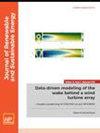Optimal Capacity of Variable-speed Pumped Storage for Wind Power Consumption based on Double-layer Stochastic Programming
IF 1.9
4区 工程技术
Q4 ENERGY & FUELS
引用次数: 1
Abstract
Configuring a certain capacity of energy storage for the power system can effectively improve the reliability of the power supply and the level of wind power consumption. This paper takes pumped storage investment cost and wind power consumption demand as the optimization goal, realizes the coordinated operation of pumped storage units and thermal power units, and considers the uncertainty of wind power and load, the multi-time scale characteristics of different types of units and load demand response, and establishes a multi-time scale pumped storage capacity optimization model based on stochastic programming. The model consists of inner and outer layers. The outer layer is investment decision-making, which decides the allocation of pumped storage capacity. The inner layer is for optimization decision-making, and the optimization operation is carried out in three stages: day-ahead short-term, intraday ultra short-term and real-time optimization. An example of a typical scenario is established, and the planning results verify the effectiveness of the proposed model and method. The Thermal-Wind-Hydro power system's total cost decreases first and then increases with the increase of the installed capacity of the pumped storage, and the curtailment rate gradually decreases. The total cost increases faster when the pumped-storage installed capacity is larger than optimal. For a pumped-storage of the same capacity, VPS is better than FPS in reducing wind curtailment rate. The main reason is that its output is continuously adjustable under the condition of the variable-speed water pump, which is especially suitable for energy storage at night when wind power is high.基于双层随机规划的变速抽水蓄能风电消纳容量优化
为电力系统配置一定容量的储能,可有效提高供电可靠性和风电消纳水平。本文以抽水蓄能投资成本和风电消纳需求为优化目标,实现抽水蓄能机组与火电机组协同运行,同时考虑风电和负荷的不确定性、不同类型机组的多时间尺度特性和负荷需求响应,建立了基于随机规划的多时间尺度抽水蓄能容量优化模型。该模型由内层和外层组成。最外层是投资决策,决定抽水蓄能容量的分配。内层为优化决策层,优化操作分日前短期、日内超短期和实时优化三个阶段进行。建立了一个典型场景的规划实例,规划结果验证了所提模型和方法的有效性。随着抽水蓄能装机容量的增加,热风水电系统总成本先降低后增加,弃风率逐渐降低。当抽水蓄能装机容量大于最优时,总成本增长更快。对于相同容量的抽水蓄能,VPS在降低弃风率方面优于FPS。主要原因是它的输出在变速水泵的条件下是连续可调的,特别适用于风力大的夜间储能。
本文章由计算机程序翻译,如有差异,请以英文原文为准。
求助全文
约1分钟内获得全文
求助全文
来源期刊

Journal of Renewable and Sustainable Energy
ENERGY & FUELS-ENERGY & FUELS
CiteScore
4.30
自引率
12.00%
发文量
122
审稿时长
4.2 months
期刊介绍:
The Journal of Renewable and Sustainable Energy (JRSE) is an interdisciplinary, peer-reviewed journal covering all areas of renewable and sustainable energy relevant to the physical science and engineering communities. The interdisciplinary approach of the publication ensures that the editors draw from researchers worldwide in a diverse range of fields.
Topics covered include:
Renewable energy economics and policy
Renewable energy resource assessment
Solar energy: photovoltaics, solar thermal energy, solar energy for fuels
Wind energy: wind farms, rotors and blades, on- and offshore wind conditions, aerodynamics, fluid dynamics
Bioenergy: biofuels, biomass conversion, artificial photosynthesis
Distributed energy generation: rooftop PV, distributed fuel cells, distributed wind, micro-hydrogen power generation
Power distribution & systems modeling: power electronics and controls, smart grid
Energy efficient buildings: smart windows, PV, wind, power management
Energy conversion: flexoelectric, piezoelectric, thermoelectric, other technologies
Energy storage: batteries, supercapacitors, hydrogen storage, other fuels
Fuel cells: proton exchange membrane cells, solid oxide cells, hybrid fuel cells, other
Marine and hydroelectric energy: dams, tides, waves, other
Transportation: alternative vehicle technologies, plug-in technologies, other
Geothermal energy
 求助内容:
求助内容: 应助结果提醒方式:
应助结果提醒方式:


